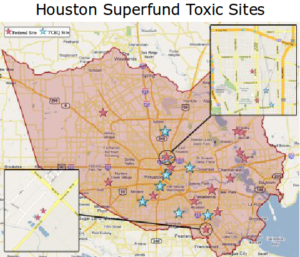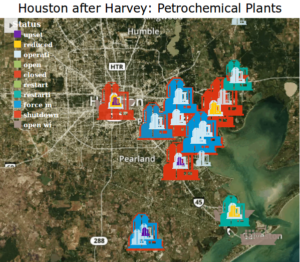Stretched along the Gulf Coast of Texas and Louisiana are some 840 petrochemical plants and refineries, as well as above-and-below ground oil storage tanks, and gas and oil export terminals. In addition, a large number of the more than 170 Texas Superfund sites are concentrated along the coast, 15 of which are in Houston alone. The floodwaters that covered the entire region have created a public health catastrophe that will persist long after the waters recede. Contributing factors are fecal coliform from swamped sewage treatment plants, molds growing in saturated structures, failure of some municipal water supply systems, inundated oil tank farms, leaking chemical plants and refineries, noxious plumes from fires, and the flooded Superfund sites – Harvey Aftermath: A Public Health Crisis in the Making.

There are quite a number of media stories about these various environmental disasters, but one of the more revealing views comes from the industry itself. A commercial group called Independent Chemical Information Service is the world’s largest petrochemical market information provider of pricing information, news, analysis and consulting to buyers, sellers and analysts. They examine in real time the status of supply and demand within 180 commodity markets, and their website has an interactive map to search for information on given products or companies. This map is very busy at the moment, with status reports on every business affected by Hurricane Harvey – Hurricane Harvey impact on the petrochemical markets (interactive map). You can view the entire Gulf Coast, zoom to a regional level, or to a city, or even down to neighborhood scale. Hover over the icon for a company, and see it’s status from a list including: shut down, reduced, restarting, operating, etc., and some disturbing categories such as “upset”, “closed”, and “force majeure”. “Force majeure” is a legal term, referring to a company’s inability to produce a product or service following a storm or other unanticipated event.

While floodwaters and storm winds may have affected the region as a whole, Harvey dumped most heavily on Houston proper. And in Houston, the worst effects are being felt by what are called “fence line” neighborhoods, or environmental justice (EJ) neighborhoods. The Union of Concerned Scientists reported that more than a million pounds of emissions from the oil refineries and chemical plants that border EJ communities have been released into the Houston air. Both common sense and real estate appraisal tell us that land nearby to polluting industries is of poor marketability, so it’s the poor who end up living there. In Houston, the toxic impacts are worse than anywhere else. Houston is the only major city in North America without land use zoning. While other U.S. cities might allow housing to be located somewhat near to industrial sites, in Houston, residential use is allowed immediately across the fence or street from industrial uses – fence line neighborhoods. These neighborhoods are predominantly low-income and ethnic minority areas. It’s no surprise that both polluting industries and EJ neighborhoods are clustered in east Houston. You may want to sign this petition to Congress – Harvey relief MUST address the needs of fenceline communities.
The UCS has paired up with one of the most active EJ groups in Houston – the Texas Environmental Justice Advocacy Services (TEJAS) – TEJAS. Other groups such as the Houston Hip Hop Caucus are addressing the Harvey issues, but TEJAS has been central to EJ organizing for decades, during everyday living conditions and in crisis situations. TEJAS is notifying neighbors about toxic exposure safeguards, giving media interviews, and has filed a court motion to stop the EPA from delaying the Chemical Disaster Rule. Most notably, in response to the explosion and fire at the Arkema liquid organic peroxides factory in Crosby TX, TEJAS is urging nearby residents to evacuate, and pushing for full disclosure of the chemicals used in the facility. To donate to TEJAS, click this link – Donate to the TEJAS Harvey Fund, and be reassured it will go to disaster relief on the ground, not into the bureaucracy of a national agency.

On 31 August 2017, flooding interrupted electric supply to the Arkema peroxides plant. With no back-up power to keep storage tanks of chemicals refrigerated, rising temperatures triggered two spontaneous explosions. Fifteen police officers were taken to a hospital for inhaling fumes, while a 1.5-mile evacuation zone was imposed. Rather than allow the remaining tanks to reach explosive temperatures, on 2-3 September, the company staged “controlled ignition” of six more tanks (set them on fire), to “neutralize” the chemicals as the company described it – Evacuation zone around Arkema’s Texas plant lifted after controlled ignitions. TEJAS and UCS and others had demanded full disclosure of what was in the tanks, and what compounds would then be in the black smoke that neighbors would be breathing, but Arkema refused – (video) Smoke from chemical plant fires caused by Houston flood raises concerns, and As Arkema Plant Burns, Six Things We Know About Petrochemical Risks in the Wake of Harvey.
This report is just the tip of the iceburg. The UCS recommended these additional resources:
- What’s the connection between climate change and Hurricane Harvey?
- Flooding from storms can place people at risk of drowning, contaminate water, cause sewage systems to overflow, and create mold–what you need to know.
- Central Gulf Coast’s electric grid is exposed to inundation from such a storm.
Some other sites for further reading are:


Recent Comments